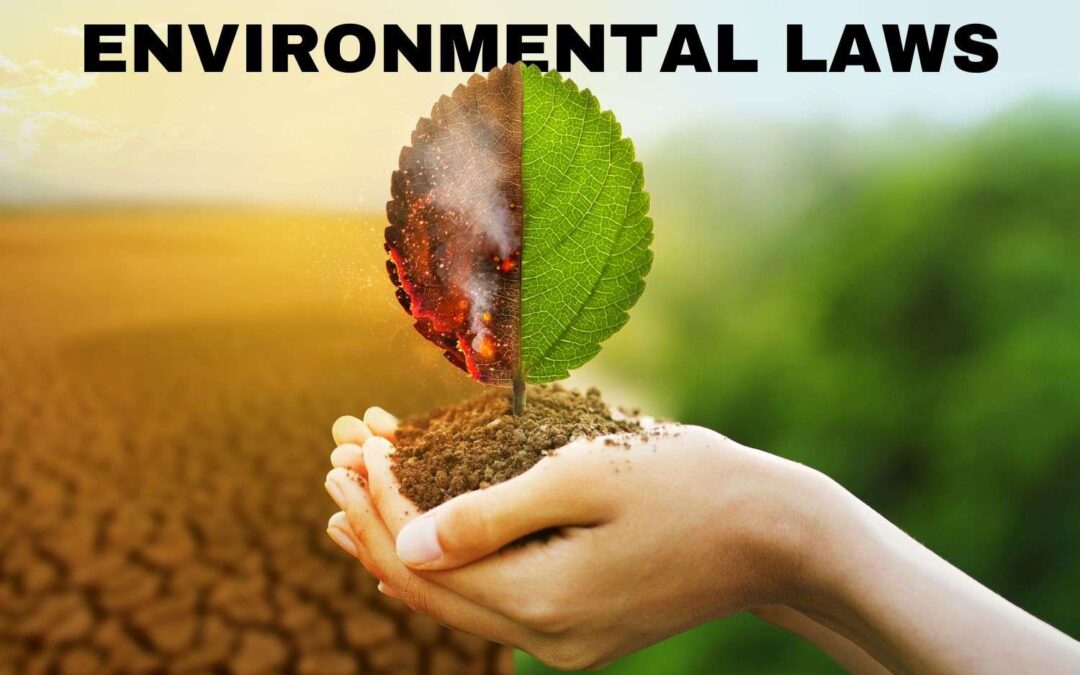I. ABSTRACT
India’s got this amazing mix of ecosystems and natural resources, but it’s also dealing with some serious environmental messes. We’re talking pollution, deforestation, losing all kinds of animals and plants, and climate change. They’ve got laws like the Environment Protection Act of 1986 and the Air (Prevention and Control of Pollution) Act of 1981, but honestly, these laws sometimes just don’t cut it. Why? Well, rapid urban growth, booming industries, and a growing population aren’t helping. It’s like having a bunch of rules but not really following them because folks don’t know better, or maybe the policies are just plain bad. Plus, the economy often butts heads with conservation efforts.
Even with a ton of laws aimed at protecting the environment, things often go haywire. Public ignorance, clumsy administration, loopholes in policy-making, and priorities that clash with conservation goals are to blame. It’s like having a strong set of rules but not really making them work. To fix these problems, India needs to tackle institutional, economic, and political issues. Crazy as it sounds, that’s the way forward.
II. Introduction
India boasts a rich blend of ecosystems and natural resources, yet faces significant environmental challenges such as pollution, deforestation, and climate change. Despite laws like the Environment Protection Act of 1986, rapid urbanization, industrial growth, and a rising population hinder effective enforcement. The clash between economic priorities and conservation efforts, coupled with public ignorance and weak administration, undermines the impact of environmental laws. To address these issues, India must confront institutional, economic, and political hurdles for meaningful progress.
III. India has some pretty important environmental laws, and they’ve been around for a while.
3.1. Water (Prevention and Control of Pollution) Act, 1974
This was one of the first laws in India that really tried to tackle water pollution. It set up Pollution Control Boards at both the state and central levels to keep an eye on things and make sure industries weren’t just dumping waste wherever they felt like it.
3.2. The Air (Prevention and Control of Pollution) Act, 1981
Now, this law is all about air pollution. It’s like the big brother to the water act but for the air. It realized that emissions from factories and cars were messing things up, so it set up a system to keep that in check across India. The act laid down air quality standards and established Central and State Pollution Control Boards. These boards are like the air police, making sure everyone follows the rules.
3.3. Environment (Protection) Act, 1986
This one came about after the Bhopal disaster, which was a real wake-up call. It’s like an umbrella law that covers air, water, and soil pollution all in one go.
3.4. Wildlife (Protection) Act, 1972
This act was put in place to protect wildlife and stop illegal trade and habitat destruction. It created national parks, wildlife sanctuaries, and conservation reserves. It also sorted species into different categories with varying levels of protection. While it helped curb illegal hunting, industrial projects and encroachments are still a big threat to wildlife habitats.
3.5. Forest Conservation Act, 1980
This act was all about stopping deforestation and land-use changes to save India’s shrinking forests. It made it illegal to use forest land for non-forest purposes without getting a thumbs-up from the central government first.
3.6. National Green Tribunal Act, 2010
The act established a National Green Tribunal, which is a specialized body dealing with environment cases. NGT is instrumental in rapidly disposing off cases and ensuring that environmental laws and regulations are effectively enforced.
IV. Challenges in Implementation
Even though India has a bunch of laws on paper, putting them into action is a whole different ball game. States run into all sorts of roadblocks when trying to enforce these environmental rules:
4.1. Industrial Pressure and Economic Issues:
Economic growth often clashes with keeping the environment safe. Industries get pushed to focus more on making money than following the rules. Plus, the regulatory folks just don’t have enough resources, and corruption is a real pain, making it tough to enforce the laws. Lots of communities don’t even know what their environmental rights and duties are, so local enforcement? Yeah, not happening.
4.2. Inadequate institutional capacity:
Most of the environmental agencies, like the Central Pollution Control Board and State Pollution Control Boards, are running on empty. They’ve got too few resources, not enough staff, and hardly any training. This means they can’t really do regular inspections or keep an eye on things like they should.
4.3. Bureaucratic Inefficiency:
Trying to get environmental laws off the ground is like wading through molasses. Bureaucratic delays, red tape, and complicated procedures slow everything down. This can hold up everything from issuing permits to cracking down on violators and taking corrective action. It’s like trying to run a marathon with your shoelaces tied together.
V. Weak Judicial and legal framework
5.1. Slow Judicial Process:
India’s judicial system has undoubtedly made a significant contribution to environmental protection, but a sluggish court is an excellent reason for violators of the environmental law not to fear. Some of the cases take a decade or two to get resolved, so the criminals that cause the problem through illegal avenues utilize more advantages of the law due to the time that has passed by. This neither advantage the regulators nor is there the deterrence of legal action.
5.2. Ineffective Implementation of Court Orders:
Although the courts frequently issue the instructions for the enforcement of various environmental protection laws or the punishment of the offenders, however these orders are hardly ever complied with or very rarely the implementation is possible. Lack of the cooperation between the judiciary and the law-enforcement bodies, for example, environmental pollution control boards, has led to the worst condition.
VI. Economic Pressures and Developmental Imperative
6.1. Economic Development vs. Environmental Conservation:
Consequently, with economic advancement being the dominant trend, people have had to choose between economic prosperity and environmental quality. Industrialization and urbanization, which has given economic growth an upper hand, have not always been favorable to environmental protection. Growth of infrastructure, factories, and mega-cities can in a few cases, flout environmental laws, in order to make money. It is likely that they may decide to abandon measures aimed at eco-friendliness to achieve economic viability.
6.2. Corruption and Lobbying:
Powerful corporate interests and vested interests actively work to circumvent environmental laws thereby reducing the effectiveness of the law’s operations. The corruption in regulatory agencies that the last set of eggs-layers talk about includes such serious issues as bribing regulatory officials, neglecting the enforcement of some rule in the name of compensation, and the granting of favors for political reasons, which as a result, exhausts the law of environment.
VII. Lacking Public Awareness
7.1. Limited Environmental Literacy:
Lots of us don’t know about environmental laws, a big part of it is because we do not care, hence the possible benefits and the punishment for disobeying are ignored. The majority of industries and people do not have an exact perception of the environmental regulations that affect them and the accompanying penalties. Lack of environmental education is a common occurrence and people even degrade the environment.
7.2. Weak Community Participation:
It is beyond doubt that the implementation of environmental laws will be influenced by the degree of community involvement and their individual community activism. Unfortunately, it is the case in many places that the communities are not that strong, and they can’t have a say in the local authorities to issue out necessary environmental controls. At times, inadequate participation of the community has been resulted in the failure to tackle environmental problems through decision processes.
VIII. Weak Data Collection and Monitoring Mechanism
8.1. Poor Monitoring Infrastructure: Veritable implementation of environmental laws necessitates the use of appropriate equipment-such as monitoring and collecting data systems. In terms of India, the monitoring system of the total pollution levels, deforestation, animal slaughter, and continental area is usually inferior or outdated. This not only leads to the wrong allocation of fines but also, the inability to acknowledge the effectiveness of laws and another step for further compulsory action.
8.2. Intermittent Data Collection Environmental monitoring is deconcentrated in the sense that it is generally decentralized with several agencies or areas which often results in incomplete or inconsistent data. Poor technology, less coordination, and less technology real-time monitoring capacity together with utilization of old-style measuring devices instead of using advanced instruments are blamed for deficient enforcement.
IX. Conclusion
The environmental legislation is one of the most impressive achievements of India, even so the real problem is their poor application and implementation. Economic, Empowering resources, Tyrant Bureaucracy, and Political Players. Exertion are the main impediments of environmental governance. Furthermore, the demand brought by industrialization, urbanization, and development on the environment creates competition between it and the violation of key regulations. Control of transgressors is the priority of public authorities and the judiciary with the involvement of the public. Such tasks can be carried out through reinforcement of governmental bodies and the creation of a database and tracking system intensifying social awareness among the population and changing the enforcement in a more severe way. It will only be possible if symphonically the government, judiciary, business, and people work together, India being capable to qualify for series of efforts to protect and safeguard its environment. Indeed, environmental law has the demand of the right persons for its efficacy. It is proposed that the green growth philosophy should be in favor of the margin of development along with the preservation of the environment in the way that the next generation gets below the energy and environment criteria than us.

